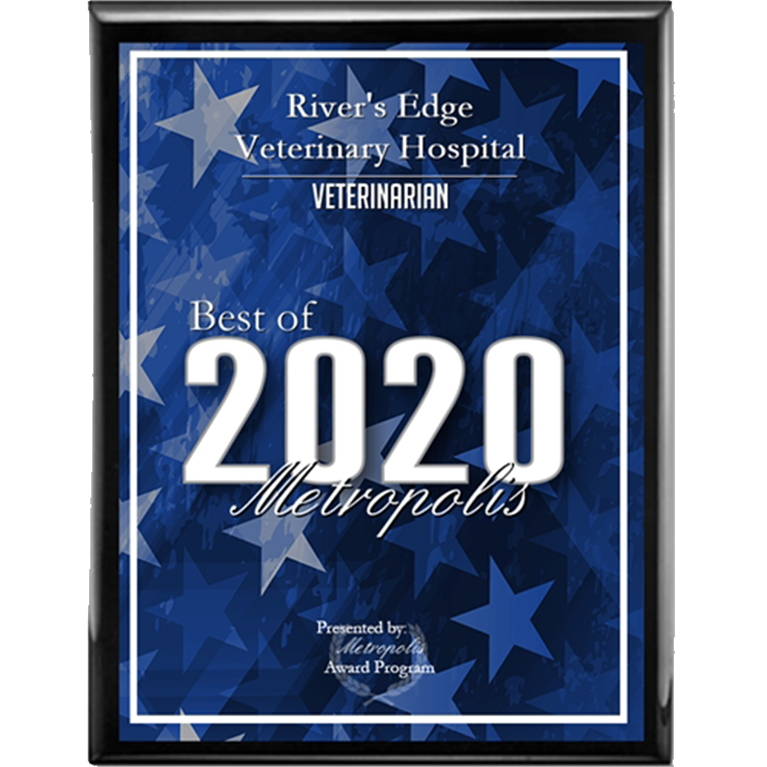
Myth or fact? Animals don’t feel pain the same way as we do. MYTH! It is a common misunderstanding that animals do not feel pain in the same way as humans, or that they are “tougher” than we are. The truth is, they have nervous systems designed very similar to ours and feel pain in very similar ways. However, we may not see it in our pets as we would expect because they are instinctively designed to hide their pain. Here at River’s Edge Veterinary Hospital we feel it is our duty to advocate for our patients, since they cannot advocate for themselves. We strive to educate pet owners on the signs of pain in our pets and the importance of pain management.
Surgical Pain Management
Post-operative pain is a common form of pain that we deal with in our beloved pets, which to our surprise, is often overlooked. At River’s Edge Veterinary Hospital, we feel that pain management is a necessary component of a surgical protocol. We use a combination of medications that target different pain receptors to attack pain from all angles. We want your pet to come home from surgery comfortable and with manageable pain
Pre-Anesthetic Protocol — prior to surgery your pet will receive an injection which will typically include pain control, sedation and muscle relaxation. Our goal here is to get your pet relaxed and to begin pain control before the pain from surgery is inflicted. Importantly, by providing these medications we are able to use less of the inhalant that is required to keep your pet asleep during surgery, which in turn reduces their risk under anesthesia. This also makes recovery from anesthesia much smoother.
Local Anesthesia — we often use local anesthetics or nerve blocks during surgery to provide additional pain control that targets specific areas. For example we use a nerve block along the dental arcades before performing extractions, testicular nerve blocks before performing a castration or cutaneous nerve blocks before a large mass removal. Similarly to the pre-anesthetic agents, use of local anesthetics allow us to use the least amount of inhalant required to keep your pet asleep, as well as provide for a smoother recovery.
Therapy Laser — we offer a cold therapy laser to use on your pets surgical site post-operatively. This technique increases blood flow, promotes cell replication, and reduces inflammation, all of which promote a faster healing time and reduce pain associated with the surgical site. This laser has a wide variety of use and can even be used along the gum-line after dental extractions. When scheduling surgery for your pet, please ask about our post-operative laser therapy option!
Take Home Pain Medication — For standard surgical procedures we send your pet home with oral pain medication for approximately four days post-operatively. We want to ensure that your pet returns home comfortable and as in as little pain as possible.
Pain Associated with Arthritis
Arthritis (or inflammation of the joint) is probably one of the most common forms of pain that we see in our pets. It can occur due to age related change (aka “wear and tear”) or secondary to a traumatic event. It can be difficult to recognize arthritic associated pain, especially in cats. Often we see our pets beginning to “slow down,” as most pet owners will describe. It may be easy to write this off as old age, but in reality the reason your pet is beginning to slow down is due to joint pain. In dogs, clinical signs to look for that may indicate your pet is developing arthritis include stiffness (especially after long periods of rest), lameness, frequent shifting and reluctance/reduced tolerance for exercise. In cats, clinical signs may not be as obvious. Many cats simply become less active, may hide, or develop behavioral changes, such as irritability, decreased grooming, or difficulty getting into position in the litter box. You may notice that they no longer jump on the counter or table tops.
Unfortunately, there is not a cure for arthritis. The main goals are to alleviate your pet's discomfort, to minimize further degenerative changes to the joint, and to restore the joint's functionality. At Rivers Edge Veterinary Hospital we offer multiple treatment options which are necessary to achieve these goals, of which include:
Joint supplements (or chondroprotective agents) will help to support the cartilage and restore production of the fluid within joints responsible for lubrication. These agents will slow the breakdown of cartilage while in turn helping to build it back up. Our joint supplements also contain ingredients that reduce inflammation within the joint. We offer joint supplements for both dogs and cats.
As a known anti-inflammatory agent, omega 3 and 6 fatty acid supplementation is another important aspect of arthritis management. These fatty acids are actually considered a “whole body health” supplement, as not only do they provide significant anti-inflammatory effects but they also promote a healthy heart and are a great supplement for skin and coat.
Non-steroidal anti-inflammatories (or NSAIDS) are an important component of arthritis therapy. It is especially important to note that there are specific medications formulated for dogs and cats and they should not take the same over the counter medications that we keep in our medicine cabinets (Tylenol, Ibuprofen, etc). They metabolize these medications differently than we do, so it is important to get something that is specifically tailored for their body’s metabolism. Side effects that you should be aware of include stomach upset, elevated liver enzymes, and potential worsening of chronic kidney disease, so it is always recommended to have routine bloodwork performed if your pet is on an NSAID long term. More advanced cases may require additional medical forms of pain control which can also be provided here at Rivers Edge.
The same therapy laser that we use post-surgically can also be used to help manage joint pain. The cold therapy laser uses specialized light to stimulate cell regeneration and increase blood flow to tissues, which in turn reduces inflammation and promotes healing and repair of the tissues within and around the joints. Typically, a patient will initially undergo a series of laser treatments that will be tapered in frequency based on their response.
Last but certainly not least, one of the most important things that you can do for your pet is keep them at a healthy weight. Excess weight on the joints will only exacerbate joint disease. It can be difficult to keep an arthritic pet at a healthy weight due to their reluctance to exercise. You can encourage low impact activities such as walking or swimming to help them keep to a healthy weight. Not only does exercise keep their weight down, but it can improve mobility in the joints and make the muscles that support the joints stronger. Be mindful of their food and treat intake, as you may need to make adjustments based on their level of activity. At Rivers Edge we will help you formulate a diet plan based on the needs of your pet. We also offer a prescription weight loss diet, for that stubborn weight that won’t come off with regular food restriction and exercise.
If you notice any signs concerning for pain in your pet, do not hesitate to call us here at Rivers Edge Veterinary Hospital! We will always be here for you and your beloved fur babies!




